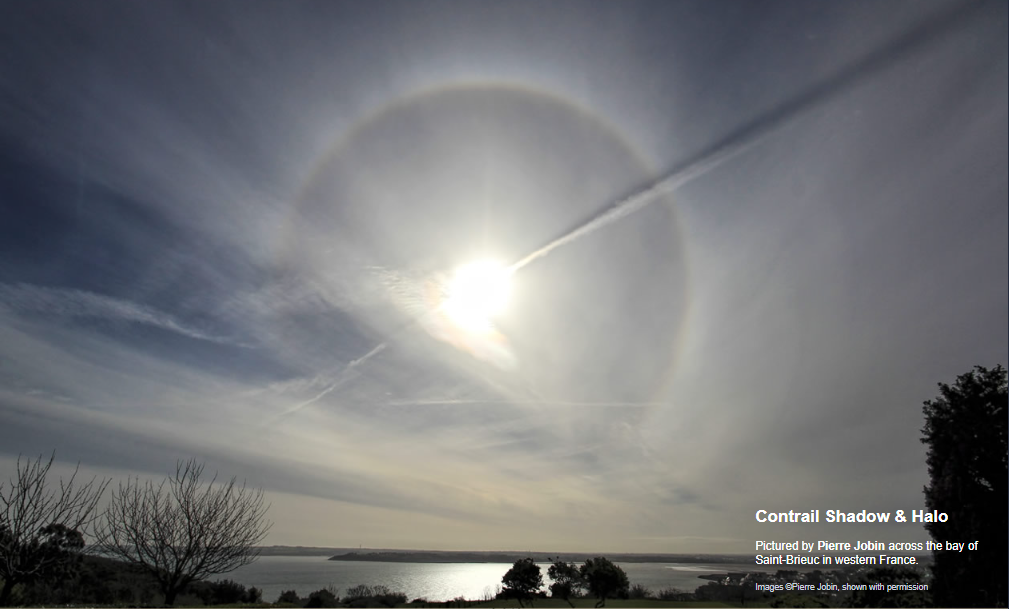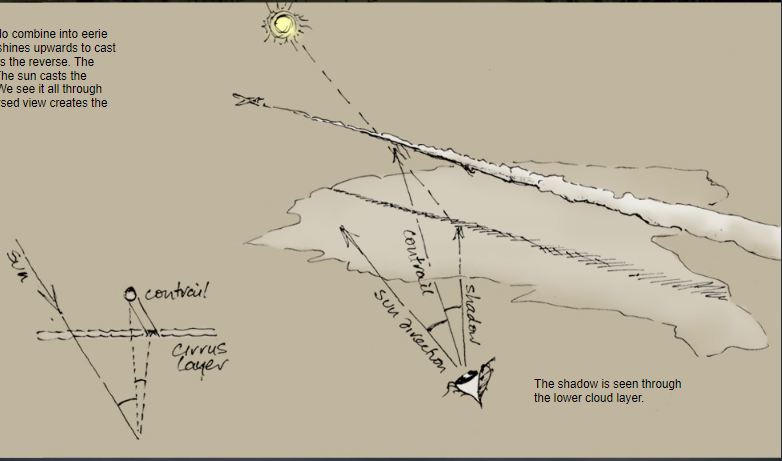Contrail shadow & halo - OPOD
Contrail Shadow & Halo: A Fascinating Atmospheric Phenomenon
Contrails, also known as condensation trails, are a common sight in the sky. These long, white streaks left behind by airplanes can create captivating atmospheric displays when combined with shadows and halos. In this article, we will delve into the intriguing world of contrail shadows and halos, exploring how they form and the optical phenomena that accompany them.
Contrary to what one might expect, the shadow cast by a contrail appears to be above a thin layer of cirrus clouds rather than below it. This illusion occurs because the cloud-diffused sunlight shines upwards, casting a shadow onto higher clouds. However, the truth is quite the opposite. The contrail is actually situated above the cirrus layer, and it is the sun that casts the shadow downwards onto lower clouds. This mesmerizing effect can be observed through the translucent screen of clouds, creating a visually stunning scene.
One of the remarkable optical phenomena associated with contrail shadows is the formation of a 22° halo. This halo is caused by the refraction of sunlight through ice crystals present in the cirrus clouds. The hexagonal shape of these ice crystals causes sunlight to bend at specific angles, resulting in the formation of a circular halo around the sun. In Pierre Jobin's captivating image, we can see how the halo appears as a dark "hole in the sky," with its inner 22° radius marked by a red edge. This red edge signifies the minimum deviation of sun rays passing through the ice prisms.
It is important to note that the 22° halo is not just a simple ring; it encompasses a wider region of the sky. The halo's inner edge marks the area where sun rays have the least deviation, while other angles and skew rays refract farther from the sun, brightening the sky outside the halo's inner edge. This creates a stunning visual effect that adds to the overall beauty of the atmospheric display.
In addition to the halo, smaller ice crystals or supercooled water droplets present in the cirrus clouds can diffract sunlight, producing iridescent colors near the sun. This phenomenon, known as iridescence, adds an extra layer of enchantment to the scene. The diffracted sunlight interacts with the tiny particles, causing the light to scatter and create a beautiful array of colors. These vibrant hues near the sun create a mesmerizing contrast against the white backdrop of the contrail and surrounding clouds.
The combination of contrail shadows, 22° halos, and iridescence results in truly ethereal scenes that captivate observers. These atmospheric displays serve as a reminder of the intricate interplay between sunlight, ice crystals, and clouds in our atmosphere. As we gaze upon these natural wonders, we are reminded of the vast complexity and beauty of our planet's atmospheric optics.
In conclusion, contrail shadows and halos are captivating atmospheric phenomena that create stunning visual displays in the sky. The interplay between contrails, cirrus clouds, ice crystals, and sunlight gives rise to mesmerizing scenes that often defy our expectations. Whether it's the shadow cast by a contrail or the formation of a 22° halo, these phenomena remind us of the intricate beauty that exists within our atmosphere. So, next time you spot a contrail stretching across the sky, take a moment to appreciate the hidden wonders that lie within.

Contrail Shadow & Halo
Pictured by Pierre Jobin across the bay of Saint-Brieuc in western France.
Images ©Pierre Jobin, shown with permission

Contrails, their shadows and a 22� halo combine into eerie scenes. The cloud diffused sun surely shines upwards to cast a shadow onto higher cloud. The truth is the reverse. The contrail is above a thin layer of cirrus. The sun casts the shadow downwards onto lower cloud. We see it all through the translucent cloud screen. The reversed view creates the illusion..
Ice crystals of the same cirrus layer refract sunlight into a 22� halo. Pierre�s image nicely shows how the halo forms a dark �hole in the sky�. Its inner 22� radius red edge marks where sun rays have a minimum deviation through the hexagonal ice prisms. Other angles and skew rays are refracted farther from the sun to brighten the sky outside the halos inner edge. The 22� halo is rather more than a ring!
Smaller crystals or supercooled water droplets have diffracted sunlight to produce the iridescent colours near the sun.
Note: this article has been automatically converted from the old site and may not appear as intended. You can find the original article here.
Reference Atmospheric Optics
If you use any of the definitions, information, or data presented on Atmospheric Optics, please copy the link or reference below to properly credit us as the reference source. Thank you!
-
<a href="https://atoptics.co.uk/blog/contrail-shadow-halo-opod-2/">Contrail shadow & halo - OPOD</a>
-
"Contrail shadow & halo - OPOD". Atmospheric Optics. Accessed on April 25, 2024. https://atoptics.co.uk/blog/contrail-shadow-halo-opod-2/.
-
"Contrail shadow & halo - OPOD". Atmospheric Optics, https://atoptics.co.uk/blog/contrail-shadow-halo-opod-2/. Accessed 25 April, 2024
-
Contrail shadow & halo - OPOD. Atmospheric Optics. Retrieved from https://atoptics.co.uk/blog/contrail-shadow-halo-opod-2/.